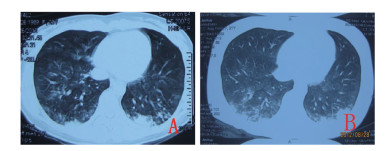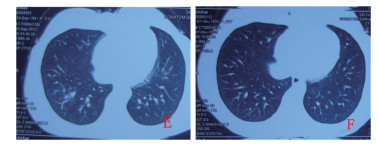Chlorine gas is a yellow-green irritant gas with the specific gravity 2.5 times that of air.It's potent ophthalmic, dermatic and mucomembranous, especially pulmonary irritant that causes acute damage in both the upper and lower respiratory tracts[1].Chlorine gas can react with water at the surface of respiratory mucosal after inhaling into the respiratory tract, producing hydrochloric acid and hypochlorous acid.Hydrochloric acid can cause the local mucosal congestion and edema, tracheal columnar epithelial cell degeneration and then necrosis, accompanying with increasing capillary permeability.Hypochlorous is easy to permeate the cell membrane and react with the cytoplasmic protein, destroy the integrity and permeability of the cell membrane, causing tissue inflammatory edema, hyperemia, and even necrosis[2].We described an adult female worker who inhaled overdose chlorine gas and caused acute chlorine poisoning during an accident in China recently.The patient recovery well and was discharged from hospital with therapy for 18 days.Two months later, the patient came back to our hospital and her's physical examination and laboratory tests were normal.
Case ReportA 21-year-old female worker after inhaling chlorine gas was presented to the emergency department at 9:00 p.m.on August 25, 2012 after being rescued with oxygen and hormone therapy for about 20 minites in the local hospital.The patient was exposed to chlorine for about 10 minutes, and then got pulmonary tightness, palpitation, cough, sputum, throat pain, tearing, dizziness, fatigue, nausea, vomiting and other symptoms.Two days later the paitent was sent to our hospitlal.The patient appeared clear consciousness, poor spirit and shortness of breath with cyanotic lips, congestion in nasal and throat, soft neck.But no skin rash, yellow discoloration of the mucous membrane or superficial lymph node enlargement was found.The bilateral pupils were large and round with diameter of 3-4 mm, sensitivity to light, and hyperemia of conjunctiva.Enhanced breath sound and diffuse moist rale were audible in both lungs and the SaO2 was 92%.The heart rate of the patient was regularly 120 beats per minutes.The abdomen was soft, neither liver nor spleen was palpable.Physiological reflex was found but pathological reflex was not elicited.The other results were unremarkable.The initial electrocardiograph showed sinus tachycardia with flat or inverted T wave.The patient denied any history of respiratory disease, cardiovascular disease, or any systemic illness.Computed tomographic manifestations of brain showed no abnormalities.But high resolution CT(HRCT) of lung showed consolidation and edema.According to China Diagnosis Criteria of Occupational Acute Chlorine Poisoning (GBZ65-2002), the patient was coincidence with the occupational acute moderate chlorine poisoning.
The patient was admitted to stay in bed with high-flow oxygen given, ambulatory blood pressure, ECG, respiration and oxygen saturation being monitored.For symptomatic therapy, high dose of glucocorticoid steroid was injected in the early stage, proton pump inhibitors (lansoprazole) was given to protect the gastric mucosa and promote mucus excluding.The diuretic was admitted for dehydration.Other therapy included maintaining water-electrolyte balance, protecting vital organs and so on.After 3 days, the cough and dyspnea were relieved, the color of the sputum became white from yellow, the heart rate became normal, and the discomforts of eyes and throat were significantly reduced.One week later, the main symptoms disappeared cept a few of cough and expectoration.The patient has recovered and was discharged from the hospital with combination treatment mainly including glucocorticosteroid for 18 days.The results of pulmonary HRCT, lung function and other major organ examinations, rechecked two months after discharge, showed no obvious abnormalities.The dynamic changes of the patient's pulmonary HRCT were shown as Fig. 1-3.

|
Figure 1 Lung HRCT obtained 2 days after chlorine gas inhalation (A), pulmonary consolidation and edema could be seen.Lung HRCT obtained 3 days after chlorine gas inhalation (B), pulmonary consolidation and edema could be seen.Lung lesions increased compared with that of A. |

|
Figure 2 Lung HRCT obtained 7 days after chlorine gas inhalation (C), pulmonary consolidation decreased and ground-glass opacity could be seen.Lung HRCT obtained 12 days after chlorine gas inhalation (D), patchy dense shadow and fibrous shadow could be seen. |

|
Figure 3 Lung HRCT obtained 17 days after chlorine gas inhalation (E), fibrous shadow could be seen.Lung HRCT obtained 75 days after chlorine gas inhalation (F), normal. |
Chlorine gas is a potent pulmonary irritant that causes acute damage in both the upper and lower respiratory tract[3].The severity of chlorine poisoning was associated with the concentration and the duration of gas inhaling.The major presenting symptoms and signs included acute dyspnoea, chest discomfort, cough, eye irritation, giddiness, vomiting, and heaviness in the head, tachycardia, tachypnoea and polyphonic wheezing[4].Myocardial infarction, acute ischemic stroke, and hyperglycemia triggered by acute chlorine gas inhalation and pneumomediastinum from acute inhalation of chlorine gas have also been reported[5, 6].Severe chlorine gas poisoning patients need mechanical ventilation.It requires a high index of suspicion for diagnosis and rapid treatment.The proper use of ventilator, timely and effective treatment of original disease, and multiple system organ support had significant impact on the prognosis[7, 8].Because there is no effective antidote for chlorine poisoning, it's critical to prevent and treat pulmonary edema as early as possible for successful treatment.Glucocorticoids, with the effect of reducing capillary permeability, and inhibiting the release of inflammatory mediators, can be early used by adequate doses to significantly shorten the course of the disease and improve prognosis[9].Oxygen therapy and keeping sedation with the right position are beneficial for sputum excluding and reducing pulmonary complications.High resolution computed tomographic manifestation plays crucial roles in both early diagnosis and judgment of disease state[10].This paient's Lung HRCT has a typical clinic feature and showed dynamic changes, including acute chemical bronchopneumonia, diffuse interstitial, partial pulmonary edema, partial consolidation and ground-glass change.The lung damage of the patient in this case recovered completely with normal HRCT manifestation and pulmonary function 75 days later.
ConclusionWe presented a 21-year-old female worker who inhaled excessive chlorine gas in an accident and was caught by serious acute lung injury.Combination treatment mainly including glucocorticosteroid was effective to acute lung injury caused by chlorine poisoning.and the patient recovered well after prompt and appropriate management.
Disclosure StatementNone of the authors has any financial or other potential conflicts of interest.
| [1] |
Parimon T, Kanne JP, Pierson DJ. Acute inhalation injury with evidence of diffuse bronchiolitis following chlorine gas exposure at a swimming pool[J]. Respir Care, 2004, 49: 291-294. |
| [2] |
Zhu J, Wang DX. Acute chlorine gas induced bronchial asthma in two patients[J]. Zhonghua Lao Dong Wei Sheng Zhi Ye Bing Za Zhi, 2007, 25: 425-426. |
| [3] |
Cevik Y, Onay M, Akmaz I, Sezigen S. Mass casualties from acute inhalation of chlorine gas[J]. South Med J, 2009, 102: 1209-1213. DOI:10.1097/SMJ.0b013e3181bfdc67 |
| [4] |
Mohan A, Kumar SN, Rao MH, Bollineni S, Manohar IC. Acute accidental exposure to chlorine gas:clinical presentation, pulmonary functions and outcomes[J]. Indian J Chest Dis Allied Sci, 2010, 52: 149-152. |
| [5] |
Kose A, Kose B, Açikalin A, Gunay N, Yildirim C. Myocardial infarction, acute ischemic stroke, and hyperglycemia triggered by acute chlorine gas inhalation[J]. Am J Emerg Med, 2009, 27(1022): e1-4. |
| [6] |
Li B, Jia L, Shao D, Liu H, Nie S, et al. Pneumomediastinum from acute inhalation of chlorine gas in 2 young patients[J]. Am J Emerg Med, 2011, 29(357): e1-4. |
| [7] |
Traub SJ, Hoffman RS, Nelson LS. Case report and literature review of chlorine gas toxicity[J]. Vet Hum Toxicol, 2002, 44: 235-9. |
| [8] |
Heidemann SM, Goetting MG. Treatment of acute hypoxemic respiratory failure caused by chlorine exposure[J]. Pediatr Emerg Care, 1991, Apr, 7(2): 87-88, 151. |
| [9] |
Xia XY, Zheng QH, Yue MX. Treatment of acute chlorine poisoning with chemical-induced lung injury using high-dose dexamethasone combined with anisodamine:a report of 526 patients[J]. Zhongguo Wei Zhong Bing Ji Jiu Yi Xue, 2012, 24: 689. |
| [10] |
Liu ZJ, Huang DJ, Wang ZQ, Wang ZG, Chang SH. Radiographic and computed tomographic manifestations of chest in patients with acute chlorine gas poisoning[J]. Zhonghua Yi Xue Za Zhi, 2010, 90: 2740-2744. |
 2017, Vol. 1
2017, Vol. 1

